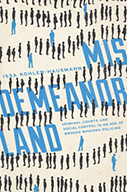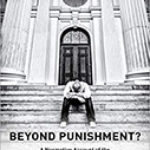Misdemeanorland: Criminal Courts And Social Control In An Age Of Broken Windows Policing

Author: Issa Kohler-Hausmann
Publisher: Princeton, NJ: Princeton University Press, 2018. 308p.
Reviewer: Sam Bieler | July 2019
Surveying the current justice reform movement, an outside observer might well conclude that at least one part of the system, the courts, are doing their job. Police face frequent criticism as an institution and certain sentences or practices like bail may be the subject of condemnation. It is rare, however, that someone looks at the day to day operation of the courts and says that the very heart of our adjudicatory process is broken. This makes Issa Kohler-Hausmann’s expertly researched Misdemeanorland all the more unique and vital. The book does a masterful job of dissecting the history and operations of New York City’s misdemeanor courts, arguing that they have become instruments of social control rather than neutral tribunals. While a reader will be left pondering precisely what social norms the courts seek to enforce, they will come away with a view into the world of New York courts that is as detailed and nuanced as it is troubling.
Misdemeanorland argues that far from being neutral tribunals assessing innocence and guilt, New York City’s misdemeanor courts have become instruments of social control. Overwhelmed by a mass of low-level arrests in the 1990s, these courts stopped adjudicating cases or handing out formal punishments and started implementing a “managerial model” where people were rewarded or penalized based on their ability to perform compliance with various rules and structures imposed by the court. Gone is Malcom Feeley’s “the process is the punishment” misdemeanor court where the informal process was at least designed to take the place of formal punishment. Now, the process is both the means and the ends of a system whose major focus is compliance with its edicts.
The research marshalled in support of this argument is impressive. Kohler-Hausmann has undertaken an impressive array of interviews, statistics, and historical reviews to make her point. Anyone who has spent time in a public defender or district attorneys’ office in one of New York’s five boroughs will immediately recognize the slang – getting rid of weak charges with a “dis con”, disorderly conduct charge, or watching a case get “30.30’d”, dismissed on a speedy trial charge. Misdemeanorland uses these terms and the rich interviews they come from to bring the reader onto the front lines of New York’s justice system.
This depth comes through particularly clearly in Misdemeanorland’s review of the history of Broken Windows policing in New York City. The tale of how the NYPD developed and deployed Broken Windows has been retold in dozens of books and articles, so it is a tribute to Kohler-Hausmann that she found so much new to say about its deployment. Vital but often overlooked players in Broken Windows like Jack Maple, get their due, and the individual crimes that made up the explosion in New York’s justice system are categorized and explored.
When Kohler-Hausmann turns her magnifying glass on the courts, the results are just as impressive. Everything from the records or “marks” defendants accumulate in various databases during criminal processing to the indignities of sitting in precinct holding cells are explored and evaluated as instruments of social control. She is also unafraid to go after popular ideas like using courts to deliver or mandate services like anti-shoplifting or anger management. Through rich discussions with people going through the misdemeanor courts, she suggests that people are put into services not for their benefit, but to show they can tick the boxes the court sets out for them. If they can obey the rules, if they can be controlled, they get leniency.
This is just one highlight of a book that challenges every assumption about the operation of New York’s misdemeanor courts. The prose and academic references will at times get somewhat dense for the casual reader, but the reward is well worth it. Misdemeanorland is, without doubt, the definitive legal and operational history of Broken Windows policing in New York City and an invaluable view into how New York’s low-level offense system actually functions.
These first-hand reports and detailed interviews might lead a reader to think that Misdemeanorland promises an in-the-trenches view of the justice system – a public defender’s complement to Jill Leovy’s detectives in Ghettoside or Steve Borgia’s judges in Court 302. But with its detailed statistical reviews and academic rigor, Misdemeanorland should be more properly identified as the successor to John Pfaff’s Locked In – the two belong next to each other on the shelf. Pfaff promises to explain why the American felon and prison population exploded — Kohler-Hausmann offers to do the same for misdemeanors.
Indeed, it is a tribute to Kohler-Hausmann’s thoroughness that the only major question a reader will come away with is what social control courts are enforcing. Misdemeanorland posits that the misdemeanor justice system serves to enforce social order, and by the end the reader must at least acknowledge that it makes a compelling case for its argument. Yet the book says almost nothing about what the tenets of this social control are or who developed these values. When Kelling and Wilson first wrote the eponymous Broken Windows, their answer was the community – their “Officer Kelly” knew and enforced the informal rules of his block which consisted not of statutes, but of a code developed in collaboration with the “regulars” who lived on his block. In short, Kelling and Wilson’s Broken Windows was social control through norms defined by neighborhoods and enforced by their beat cop.
Whatever the merits of this system, it is clearly not the policing that arrived on New York’s streets in the 1990s. As Kohler-Hausmann documents, courts and cops are not overly concerned with knowing or assessing the norms or informal rules of a particular block; such a fantasy cannot be sustained when the police are out writing tickets for selling water bottles out of a cooler without a vendor license. Yet it is also not purely legalistic, enforcing the legislature’s statutes with a relentless “the law is the law” ethos.
There is clearly a system of values animating these courts, but the reader is left grasping to determine what it is. Defendants are rewarded or punished for complying with certain practices and for making certain performances before the court. Yet it is not clear why this amounts to social order, unless the term is mere short hand for compliance with a judge’s demands. If it is something more, whether that be middle class mores or, as Chris Hayes has argued in Colony in a Nation, state-enforced white supremacy, then that message does not come through.
This question does not, however, detract from the incredible contribution Misdemeanorland has made to the study of the courts. Kohler-Hausmann embarked on an extensive investigation of New York City’s misdemeanor justice system and found something rotten at its heart – a system of tribunals that has become more concerned with enforcing social order through compliance with its edicts than adjudicating guilt or innocence. Any serious student of the courts should be concerned with this development, and should have a copy of Misdemeanorland on their shelves as they consider what this means for the future of criminal justice.
Sam Bieler, New York University School of Law


